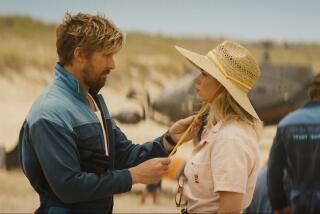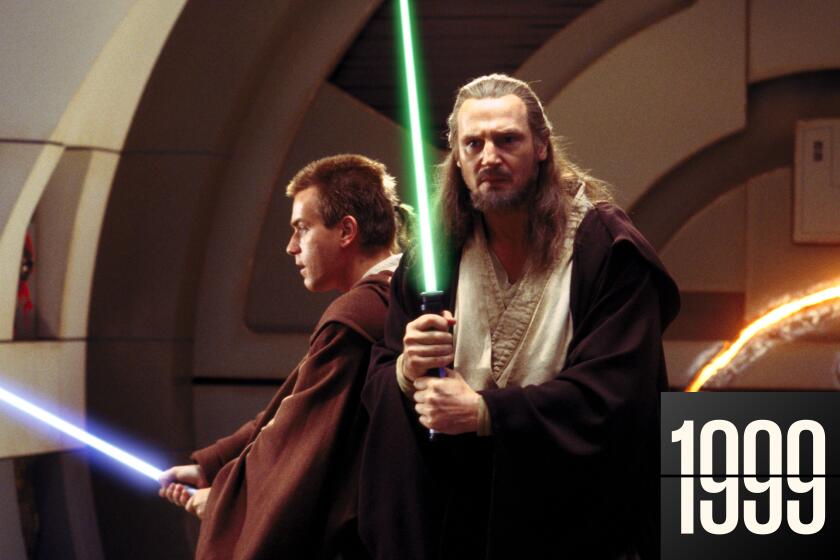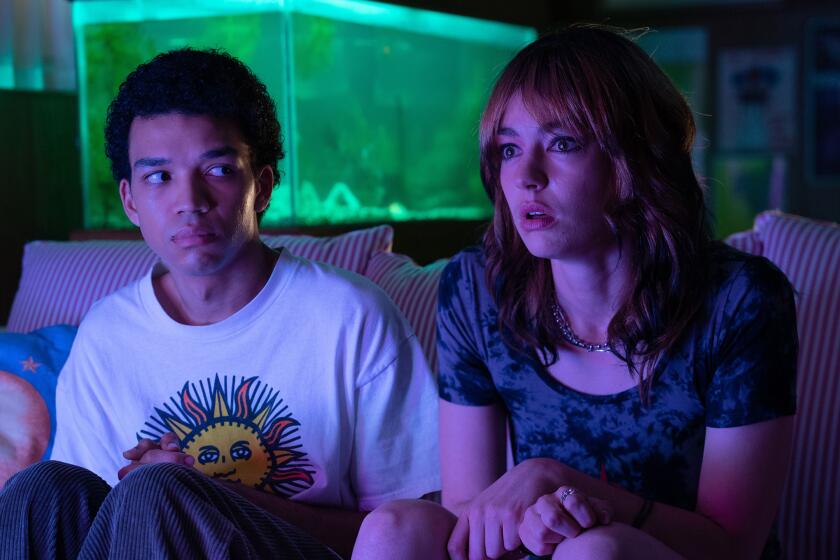An earthy dreamer
OBVIOUSLY, Carlos Reygadas hasn’t flown all this way from Madrid just to talk about oral sex.
But lately it’s been a tough subject for him to avoid. Ever since last summer, when the young Mexican writer-director’s second feature film, “Batalla en el Cielo” (Battle in Heaven), played at Cannes, there’s been some predictable squawking over what might be called the film’s highly original opening scene.
In the sequence, which is repeated as the movie ends, the camera zeroes in on a man’s broad, expressionless visage, scans the length of his pudgy torso and eventually comes to rest on the face and head of a beautiful young woman. She is clearly performing fellatio, but because the man’s genitalia are obscured by a blur of light, it’s uncertain whether we are meant to be witnessing an actual sex act or some sort of rapturous fantasy or otherworldly hallucination. As the sequence builds, a tear streaks down the woman’s lovely, pre-Raphaelite features.
That singular moment was enough to get “Batalla” pulled from a scheduled screening last week at the Sundance Festival, at Park City, Utah’s Eccles Center for the Performing Arts, which is part of a complex shared with a local high school. Though the screening wasn’t a school event and no students would have attended, school officials objected to the movie’s being shown there, a film publicist said.
The screening was moved to another venue, and “Batalla” was shown at other screenings last week as part of the festival. “Batalla” is scheduled to open Feb. 24 in Los Angeles.
During a brief stopover in his hometown last week en route to Park City, Reygadas was characteristically philosophical about the incident. “It doesn’t surprise me,” says the 34-year-old filmmaker, ensconced in a hotel room with a panoramic view of the teeming Mexican capital. “And no, I don’t get tired [talking] about it, because I know that ... many people feel something [for the film] that goes beyond that.”
It’s true: What first meets the eye in Reygadas’ films, which he wrote and directed, may be only an intriguing tease, while deeper metaphysical revelations are reserved for later. In his breakthrough film, “Japon” (2002) -- which won the Camera d’Or “special mention of the jury” award at Cannes and inspired a few normally hard-bitten critics to use words like “stunning” and “sublime” -- an unnamed man ventures into rugged rural Mexico, where he hopes to work up the will to commit suicide. Its memorable opening frames contain the image of a decapitated bird’s twitching head, a symbol that resonates louder as the film progresses.
In “Batalla,” the utterly ordinary, working-class protagonist Marcos -- the recipient of that previously mentioned erotic favor -- earns his keep as a Mexico City chauffeur. The twist is that one of his clients is a spoiled rich girl who turns tricks for kicks. Yet despite its profane beginning, the movie reaches its dramatic climax in the country’s holiest of holy sites, the Basilica of the Virgin of Guadalupe, and is bracketed by images of the ceremonial lowering of a giant Mexican flag.
Raised in a cultured upper-middle-class home and partly educated in Europe, where he later practiced international law for a time, Reygadas is an earthy cosmopolitan. Like his cinematic predecessors, the Russian Sergei Eisenstein and the Spaniard Luis Bunuel, he has a way of viewing Mexico as if through foreign eyes. Though he now makes his home in Madrid, he retains strongly mixed feelings for his gritty hometown and the culturally rich, politically troubled society it so thoroughly personifies. Though Reygadas’ films haven’t been widely seen in Mexico, where they’ve played mainly to art-house audiences, critics have praised their lyricism and ambition.
“Actually, it’s a very strange feeling” being back in Mexico, Reygadas says, “because I like it very, very much. And at the same time, well, this morning I went out for breakfast and I bought this newspaper, La Jornada. And you read and you see everything. It’s a really weird place because it’s so depressing in a way, and so miserable.”
Built around minimal dialogue, gorgeous, enigmatic imagery and sparely drawn yet strangely alluring characters, his movies reject Hollywood visual and narrative conventions and have been compared with the mature work of such avant-garde giants as Michelangelo Antonioni, Roberto Rossellini, Robert Bresson and Andrei Tarkovsky.
That’s a flattering way of saying that his future oeuvre is likely to have a select but limited following. Reygadas would be the first to agree. Though he sometimes gets lazily lumped in as part of the Mexican cinematic “new wave” that includes other young directors such as Alfonso Cuaron (“Y Tu Mama Tambien”) and Alejandro Gonzalez Inarritu (“Amores Perros”), his works are aggressively noncommercial. He’s simply not interested in packaging his ideas into neat little McMovies that can be quickly dispatched to the global cineplexes, popcorn on the side.
Instead, he prefers to keep his expenses low and his aspirations high. The budget for “Japon” was a mere $150,000, but Reygadas gave the film’s wide-angled landscapes an extraordinarily rich, multi-textured feel by shooting on 16-millimeter CinemaScope.
“I’m not an entertainer, at all,” he says. “It’s like a painting
Reygadas believes that over time, cinema has strayed from its roots as an essentially visual medium into narrative banality. In his own films, images often speak much louder than words. His human characters tend to express themselves through actions and subtle facial movements. A major plot shift may be marked by nothing more than a character’s haunted glance.
“He makes a film the way a photographer would,” compliments John Cooper, director of programming for the Sundance Festival. And audiences trust Reygadas’ sometimes playful way with images, Cooper says, “because you feel you’re in the hands of someone who knows what he’s doing.”
Whether they dwell in the vast, arid landscapes of the rural Mexican state of Hidalgo (“Japon”) or the shrill chaos of Mexico City (“Batalla”), Reygadas’ characters often are dwarfed and overwhelmed by their surroundings. The sense of man’s relative puniness in the cosmos, and his constant labors to find meaning within it, looms large in Reygadas’ elegiac artistry. Their existential struggles may lead these characters either to rediscover their sense of purpose (“Japon”) or to commit unspeakable crimes (“Batalla”). Either way, they exist in worlds that are as much metaphysical or mental states as actual places.
*
A minimalist approach
AT heart, Reygadas is a disciple of Romanticism, that sublimely elevated intellectual-artistic movement that arose in Western Europe in the 18th and early 19th centuries. The ongoing dialogue in his films between stressed-out city life and meditative country life could have been lifted straight out of Wordsworth. And he acknowledges that one particular image from “Batalla,” when the dejected Marcos seeks solace in a mountaintop overlooking Mexico City, is a direct allusion to the German painter Caspar David Friedrich’s quintessential Romantic opus “Wanderer Above the Sea of Fog” (1818).
Yet despite the occasional reference plucked from the art-historical stratosphere, his films are stripped to the most minimal components of story, dialogue and characterization. They also keep their feet firmly planted in the soil he knows best: Mexico.
“After all, I have to talk about what I know,” Reygadas reasons. “I don’t know if you’ve seen ‘Match Point’ by Woody Allen. I’ve been in that kind of world and I know it well as to relate to it. But I wouldn’t be good enough to do a film with it. I would certainly do mistakes and would go for prototypes and generalizations.”
Even as he speaks, his mental wheels are churning. Within a few minutes, he changes his mind. “I think I was all mistaken,” he blurts out, “about only being able to do a film about what I know very well.” For example, he says, the rural, peasant community depicted in “Japon” isn’t one he knows firsthand. The upper-class milieu shown in “Batalla” is more familiar to him than the movie’s other environs, of humble, working-class houses and hectic subway stations. “If you are calm and you observe and you let things flow, then you will capture truth,” he says.
To achieve this effect, Reygadas prefers to work with untrained, nonprofessional actors, because he believes their un-self-conscious ability to be in the moment may have greater verisimilitude than a professional actor’s calculated “performance.” Alejandro Ferretis, the protagonist of “Japon,” was an old family friend. Marcos Hernandez, who plays the main character in “Batalla,” used to work for Reygadas’ father. As for the woman who plays Marcos’ wife, Reygadas says he bumped into her one day in the Zocalo, Mexico City’s giant central plaza.
Some critics have murmured darkly that these casting coups come dangerously close to exploitation. But Reygadas believes that he earns his actors’ trust. “I think it’s all a matter of being really, really honest with them,” he says.
In a similar vein, he doesn’t tell his actors how to dress or even necessarily how to speak on film. “I let them provide me with all those things, rather than the other way around,” he says.
Able to converse easily in nearly flawless English as well as French, Reygadas radiates intellectual confidence. His current bedtime reading includes Kierkegaard, the Mexican Revolutionary war general Francisco Urquizo and Joseph Conrad.
He also tries to watch a movie a day; not long ago he worked his way through the Ingmar Bergman repertoire again, for the umpteenth time.
Before taking up film, he earned a law degree at the University of London, where he also played rugby. (His brother played for the Mexican national team.) His interests turned toward international law, and he became a specialist in the area of armed conflict, working for the European Union in Brussels and for the Mexican Ministry of Foreign Affairs in New York.
Seeking solutions, or dramatic resolutions, to complex ethical questions still preoccupies Reygadas in his new vocation. While he doesn’t consider his movies to be moralistic, he believes they’re concerned with ethical choices in a classic Aristotelian sense.
But in an age when many people of widely different faiths speak of good and evil as tangible forces, it’s perhaps paradoxical that as serious a filmmaker as Reygadas shuns the terms. “I just think there are acts that harm and acts that help, or heal. And that’s all that it comes down to.”
For that reason, he says, his films are not about redemption, “because to be redeemed, first you have to be condemned. You have to be evil. And for me Marcos is never evil. He’s just rotten, if you want, but something rotten is not evil, it’s just rotten.”
As for the borderline-suicidal character in “Japon,” Reygadas says, he simply realizes that he prefers life to death. Maybe, Reygadas suggests, the character is saved “just by just the curiosity of seeing every new day the sun rise again.”
“Maybe that’s a reason enough, just to keep on living.”
More to Read
Only good movies
Get the Indie Focus newsletter, Mark Olsen's weekly guide to the world of cinema.
You may occasionally receive promotional content from the Los Angeles Times.







